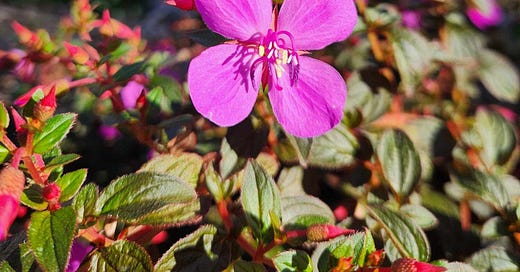Spanish Shawl
A giant mid-week hello!!
For those Brisbanites - hasn’t it been WINDY the last few days! Ekka’s not for another month!! Hope you’re all staying rugged up.
We’re generally fairly lucky in subtropical Brisbane - it doesn’t REALLY get that cold and this is just a small interlude before glorious weather resumes (until we hit the slightly longer hot and sticky interlude haha).
I got to use my chipper this weekend just gone. Did I tell you I bought a chipper at the QLD garden expo? Well I did. And it’s FABULOUS. I got a Stihl. The West Indian Lime tree needed a good haircut and it made mincemeat of the branches. Unfortunately I got very excited in the pruning/chipping process and most of the tree is now gone AND I got so scratched up by its GIANT thorns that I’ve decided the rest of the tree is likely to follow shortly and possible be replaced by a camellia. Or maybe a Michelia alba. I love the limes but I am becoming more and more intolerant of thorns prickles and spikey bits in general. So watch this space!
Have a fab week!
Kat.
Today we’re back to plant profiles and I want to talk about Spanish Shawl or Centradenia floribunda (I think..read on!). Its flowers are a shocking fluorescent purple (is fluorescent purple even a thing?) - a bright fuchsia/magenta colour which contrasts (somewhat horrendously) with its bronze foliage. Not a colour combination I would have picked, but the absolute abundance of flowers (hence the species name!) makes up for it because the leaves fade into the background.
It is in the same family as Tibouchina (Melastomataceae) which is quite evident when you look at the form of the flowers - although Spanish Shawl flowers are roughly the size of a 20 cent piece and the plant is only about 30cm high and the Tibouchinas most people are familiar with are much larger and uhh more tree size…(although there are shrubbier species).
The more research I do the more confused I become - ‘Spanish Shawl’ seems to refer to both Centradenia floribunda, C. inaequilateralis and Heterocentron elegans and while some sources suggest they’re synonyms, some imply they’re different (although very closely related). Nevertheless the difference is immaterial as they all look much of a muchness and will be perfect if you’re after an excellent, fast growing, shockingly coloured, low sprawling shrub that loves full sun and a dry area. Various cultivars are slightly taller or wider, or even different shades of foliage and flowers and although I am usually a stickler for correct identification, this is just a beautiful little ornamental and they’ll all do the same thing. Keep your eyes out for one. They’re available at nurseries and also easy to propagate via cutting so you might just find one at a garden club like I did!





